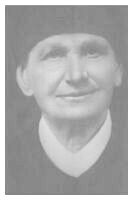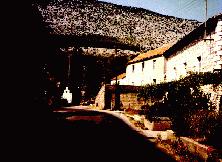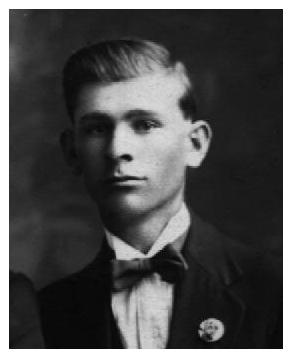from
MOMICI in DALMATIA





McMillan Genealogy Page
Neretva Delta and Dubrovnik History

FIRST GENERATION.
Mate DOMINIKOVICH.
Born in Momici Dalmatia Croatia.
Died in Momici Dalmatia Croatia.
Occupation Farmer.
Religion Roman Catholic.
He married
Mara SRSEN, 
1886 in Dalmatia Croatia.
Died in Momici Dalmatia Croatia.
Religion Roman Catholic.
They had the following children:
Ivan DOMINIKOVICH
Michael {Mick} Georgio DOMINIKOVICH
Marija DOMINIKOVICH
Bridget DOMINIKOVICH
Kate DOMINIKOVICH
Stipan Ante (Steve) DOMINIKOVICH

SECOND GENERATION

1. Ivan DOMINIKOVICH.
Son of Mate DOMINIKOVICH & Mara SRSEN.
Born 1887
Momici Dalmatia Croatia.
He married
Ana Haring.
Born in Croatia.
They had the following children:
Marija DOMINIKOVICH.
Daughter of Ivan DOMINIKOVICH & Ana HARING.
Born in Dalmatia Croatia.
She married
Josip STEPANIC.
Born in Krk Croatia.
The family emigrated to Villa Gesell in Argentina
They had the following children:
Jose Luis and Rosa Maria
Rusita DOMINIKOVICH.
Daughter of Ivan DOMINIKOVICH & Ana HARING.
Born in Dalmatia Croatia.
She married
Captain Vlado DUNATOV.
Born in Croatia.
They had the following children:
Irena and Hrvoje.
The family live in Dubrovnik
Elly DOMINIKOVICH.
Daughter of Ivan DOMINIKOVICH & Ana HARING.
Born in
Dalmatia Croatia.
She married
Fermin GONZALES
in Argentina.
They had the following children:
Eduardo, Ana Maria, and Carolina
2. Michael Georgio DOMINIKOVICH.
Son of Mate DOMINIKOVICH & Mara SRSEN.
Born 27 Sep 1893
in Momici Dalmatia Croatia.
Died 30 Sep 1987
at Waiuku New Zealand.
Buried 2 Oct 1987
Waiuku Cemetery New Zealand.
Occupation
Gumdigger, Billiard Room Owner.
He married
Perina BARN.
Born 1891.
Died 2 Nov 1975
Waiuku Auckland New Zealand.
Buried in Waiuku Cemetery. 
3. Marija DOMINIKOVICH.
Daughter of Mate DOMINIKOVICH & Mara SRSEN.
She married
GOVORKO.
They had the following children:
Mara GOVORKO
4. Bridget DOMINIKOVICH. died in 1918
Daughter of Mate DOMINIKOVICH & Mara SRSEN.
She married
Mijo SKEGRO
They had the following children:
Mare SKERGO
Stipe SKEGRO

5. Kate DOMINIKOVICH. b 1886
Daughter of Mate DOMINIKOVICH & Mara SRSEN.
Born in Momici Dalmatia Croatia.
She married in 1918
Ante YERKOVICH.b 1896
They had the following children:
Ana Yerkovich b 18 Feb 1919 died 9 Aug 2004
She married
Ante Jovica died 1944.
They had the following children:
Jelka Jovica b 1940
Senka Jovica b 1942
Ivan Yerkovich
He married in 1949
Milka Jovika

MY FATHER

6. Stipan Ante (Steve) DOMINIKOVICH.
Son of Mate DOMINIKOVICH & Mara SRSEN.
Born 4 Aug 1897
in Momici Dalmatia Croatia.
Died 17 Dec 1984
Auckland New Zealand. Buried 19 Dec 1984.
He married
Olive Mavis MCMILLAN,

Born 1 Aug 1907
daughter of Constantine MCMILLAN & Kate CAMPBELL
1931 in Auckland.
Died at Auckland
10 Dec 1999
They had the following children:

Ivan Campbell DOMINIKOVICH

Brian Stephen [STEPHENS] DOMINIKOVICH
Rex Thomas DOMINIKOVICH
Margot Kathleen DOMINIKOVICH

My Dad's village of Momici in Dalmatia.

A CONDENSED HISTORY OF DALMATIA.
Old Stone Age.
The most important discovery in the region was that of
Krapina Man and his implements in a cave near Krapina in northwestern
Croatia by Dragutin Gorjanovic-Kramberger. He excavated from 1899 through
1905 at this site, which dates back some 100,000 years.The signs of industry
found with Krapina Man are attributed to the Middle Paleolithic Mousterian
culture, with one of their characteristics being "D" - shaped stone
scrapers.
2500-1300 BC.
The history of this area dates back to the very distant past when the
Stone-Age man left the first traces on the Adriatic Coast. The remains on
the island of Hvar are 5,000 years old and are dated to the New Stone Age.
The archaeological remains from Brac and Hvar, Split, Trogir
and Sinj speak of activities in these areas during the Bronze and Iron Age,
and contribute to the beauty of historical complexity.
The Indo-European peoples spread from Pannonia to Dalmatia.
It looks as if many European groups of the Indo-European family came to
Europe, their future homeland, together. Celtic, Italic, Illyrian, Thracian,
Venetic, Germanic, Baltic and Slavic peoples, after crossing the South Russian
Steppes, reached Europe about 2500 BC and settled in the Middle Danube
valley area.
The earliest painting of a sailing boat found in Europe is that on a fragment of pottery from the neolithic settlement in the Grapčeva Cave on the island of Hvar, dating from 2500 BC. This discovery attests to the intensity of the transport of passengers and goods, as well as of traffic in ideas across the Adriatic.
In the dawn of civilization, this area was populated by Celtic and Illyrian tribes; a number of large cairns dating from those times have been discovered on the Eastern Adriatic coast and Dalmatian islands. Later Italic tribes began moving to the south, then Celtic tribes went to the west, Germanic tribes to the north. In about 1300 BC Illyrian and Venetic groups
(or one group which was later divided into two) started migrating to the
south, from Pannonia (modern Hungary) to Dalmatia (modern Croatia, Serbia
and Bosnia).
HISTORY Of DELMATIA
The meaning of the name Dalmatia or Delmatia, which is of Arnautic origin, is "land of shepherds" (delminium — pasture for sheep). The earliest mention of the name occurs at the time of the fall of the southern Illyric kingdom, 167 B.C. The people who dwelt near the rivers Neretva and Krka formed a league against the advancing Romans. Their principal town was Delminium, on the present plain of Sinj, or possibly Duvno in Herzegovina, and after that city the tribes called themselves Delmati, or Dalmati, 170 B.C. The islands were peopled by the Greeks; but the mainland by the Illyrians. The Dalmatian league soon came into conflict with the Romans.
In 153 B.C. the Roman Senate sent envoys to negotiate with the Dalmatians, but they returned complaining that they were received in an unfriendly manner, and that they would have been killed if they had not secretly escaped. During the next year war broke out. Finally Publius Cornelius Scipio Nasica conquered the land and demolished the city of Delminium. The Romans' success was incomplete; they must subdue the neighbouring Illyrians and Celts if they wished to retain the whole of Dalmatia. The two new consuls had to march from Gaul to Illyrium and occupy the city of Segestica, now Sisak, thence to invade Dalmatia and capture the city of Salona. The consul Metellus carried out this plan, defeated the enemy in 118 B.C., and celebrated a triumph at Rome, receiving the title Dalmaticus.
The Roman Senate now created the large province of Illyricum, extending southward to the River Drim, northward as far as the Julian Alps and the River Sava. The principal strategic point and fortress in this new province was the city of Salona (Solin). But the Dalmatians did not patiently bear the Roman yoke and tribute. Many uprisings broke out until the time of Octavian, who came to Illyricum in 40 B.C., and subjugated all the tribes; he made the rivers Drava and Danube the northern boundaries of the Roman possessions and sailed on them in his triremes. Later, when emporer, he broke the power of the Dalmatian and Pannonian tribes who tried again to throw off the Roman rule.
The insurrection started in the year 6 B.C. and ended in A.D. 9. The power of the rebels was crushed and their country devastated. Since the Punic wars Rome had not been in as critical a situation as during this insurrection suppressed by Tiberius.
1000-BC.
The first millenium before Christ was the period of Illyrian tribes, and the Delmati stood out in significance. This area, known to historians as ancient Illyria, was home to tough mountain barbarians during Pre Roman times. After the area was conquered by Rome and became the Roman provinces of Illyricum and Pannonia, these same hardy barbarians enlisted in the Roman army and became some of the best soldiers in the Legions. Pannonia thus became one of the prime recruiting areas for the Roman legions. Many excellent Generals came from Pannonia and Illyricum. During the late Third and early Fourth Centuries, several Roman Emperors came from this area. Experienced and competent Generals like Trajan Decius, Claudius Gothicus, Aurelian, Probus, Diocletian, Galerius, Maximianus, and Constantius Chlorus became Roman emperors. In the 4th century BC, ancient Greeks founded colonies on Dalmatian coast and islands.
To the Second Millenium A.D.
The Croats settled these areas in the first decades of the 7th century, founding a state in the hinterland with Solin and later Knin as one of its centres. In those early centuries this region was exposed to Venetian Doges and Hungarian rulers, and Klis was for several centuries the centre of the Croatian Primorska Zupanija (Littoral district). During the next centuries the inhabitants experienced the municipal system of developed European States, but also Venetian rule, Turkish attacks, and the very short period of French rule.
As the region on the outskirts of the great Austrian Empire, in the 19th century central Dalmatia was completely economically and culturally underdeveloped, yet at the same time Croatian political awareness strengthened. As a result of the awakening of the idea of Croatian National revival, the Croats took over the municipal government of Split in 1882. This encouraged National enthusiasm which was in various circumstances of the 19th and 20th century suppressed, yet never destroyed.
RECENT TIMES
Following the First World War, new borders for Austro-Hungarian Monarchy were set by the Treaties of Saint Germain-en-Laye (September 10, 1919) and Trianon (June 4, 1920).
As a result, the Austro-Hungarian Empire was utterly transformed into smaller territories and new countries.
Hungary became an entirely separate nation, but lost large portions of its territories as well, retaining only core Hungarian-speaking areas. Retained were West and Central Hungary plus a small western portion of the Banat, the northern portion of the Batschka, the Central Hungarian Highlands, and the northern portion of Swabian Turkey.
A new country of Yugoslavia was also formed including the former Austro-Hungarian lands of the southern portion of the Banat, the southern portion of the Batschka, Bosnia-Hercegovina, the southern portion of the duchy of Carinthia (Slovenia), most of the of duchy of Carniola, Croatia-Slavonia, the kingdom of Dalmatia, the southern portion of Swabian Turkey, the southern portion of duchy of Styria, and Syrmia.
(The Kingdom of Serbs,Croats and Slovenes was established on Dec. 1, 1918) renamed Yugoslavia on October 4, 1929. It existed as such until WW 2 in 1941. (Federal Republic of Yugoslavia) from 1945 to 1991. The six republics that formed the former Yugoslavia were : Bosnia and Herzegovina, Croatia, Macedonia, Montenegro, Slovenia, and Serbia.
Following WW 1, Italy took for itself the southwestern portion of duchy of Carniola, the county of Gorizia-Gradisca, the margraviate of Istria, the town of Trieste, the southern portion of the county of Tyrol, city of Zadar (formerly part of the Kingdom of Dalmatia), and the islands of Cherso/Ceres, Lusino/Los^inj, and Lagosta/Lastovo.
The 1947 (WW 2) peace treaty recognized Yugoslavia's acquisition of the former Italian territory. This included Dalmatian city of Zadar/Zara and the islands of Cres/Cherso, Los^inj/Lusino, and Lastovo/Lagosta, as well as former city of Rijeka/Fiume and, farther north, western Slovenia and part of Istria.
1867-1918 Istria was part of of Austria under the dual Austro-Hungarian
Monarchy.
1918-1947 Istria was part of Italy, not Croatia or Yugoslavia.
Today, Trieste is not part of Istria nor of Croatia, but of Italy.
In 1947, the Free Territory of Trieste was created .
Zone A (city of Trieste) was administered by Anglo-American forces
and Zone B by the Yugoslavs.
In 1954, the Free Territory of Trieste was abolished.
Zone B was given to former Yugoslavia and Zone A was given to Italy
Today Croatia proudly stands among the Nations of Europe.
iceedee@gmail.com.net.nz
Made by IVAND
Thank you for visiting my page.
Please come back and visit again!
MY GUESTBOOK

View My Guestbook
Sign My Guestbook
FAVOURITE LINKS



